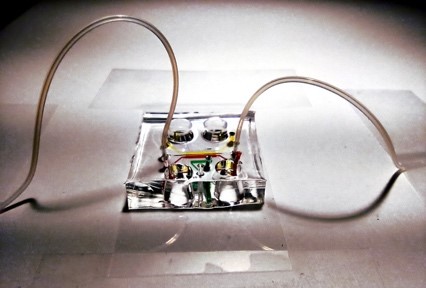The results of this study appear November 1
st, 2021 in
The journal of Cell Biology.
Hematopoietic stem cells (HSC), present in the bone marrow, are the source of all blood cells (macrophages, lymphocytes, neutrophils, red blood cells, platelets, etc.). The slightest defect in this differentiation process can lead to serious diseases (leukemia, immune deficiency, lymphopenia, myelodisplasia). But these errors are difficult to investigate because HSCs operate in the core of the bone marrow, which is difficult to observe because of the opacity of the bone.

Microfluidic chip.
To achieve this, researchers developed a transparent microfluidic chip (left) with different compartments containing each of the cell types present in the marrow. By injecting the HSCs into the chip
via microchannels, the researchers discovered that the HSCs move around and "visit" the cells that line the bone structure.
By zooming in on the internal structure of HSCs, the researchers noticed that the nucleus of undifferentiated HSCs or HSCs destined to become lymphocytes (lymphoid pathway) is homogeneously surrounded by cytoskeletal constituents (microtubules). In contrast, the nucleus of HSCs that are intended to become macrophages or dendritic cells (myeloid pathway) is strangulated and highly deformed. Biologists then show that the inner architecture of the cells directs the differentiation of HSCs (
previous publication).

The microtubule network (yellow) of a HSC (left) has "hooked up" to a bone marrow cell (right).
© M.Thery/CEA
When HSCs come into contact with bone marrow cells, a totally unexpected phenomenon occurs: they anchor and elongate while completely reorganizing their internal architecture.
To better understand this new mechanism of HSC "polarization" on bone cells, the researchers rely on the new chip they have developed which, through an array of microwells, allows contact between a marrow cell and a single HSC. The polarization of the HSC can then be observed from different angless.
This discovery, and the development of "bone marrow on a chip" that made it possible, opens up completely new avenues of research into diseases linked to hematopoietic stem cell dysfunction, and in particular leukemia. Do leukemic stem cells polarize normally when they come into contact with the marrow? If not, what is the impact of this defect on the proliferation of cancer cells? The chips will allow the analysis of the effect of new compounds on the migration, anchoring, polarization and proliferation of stem cells and tumor cells and thus identify future drugs.